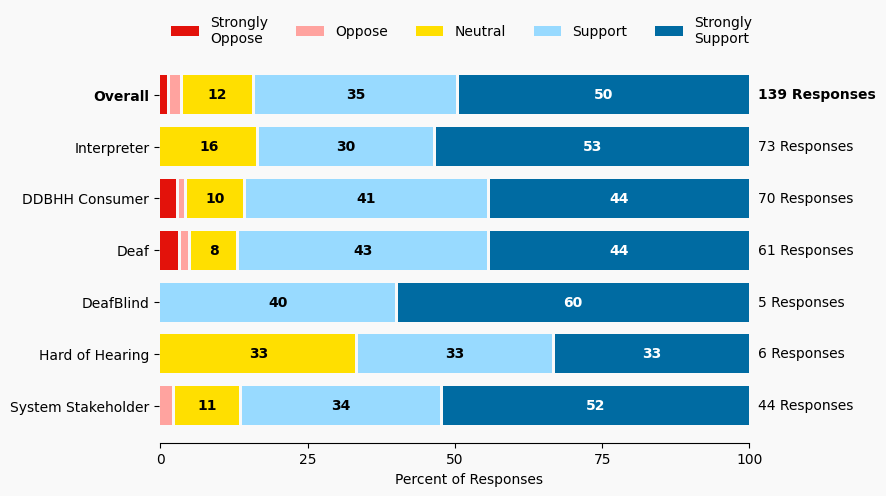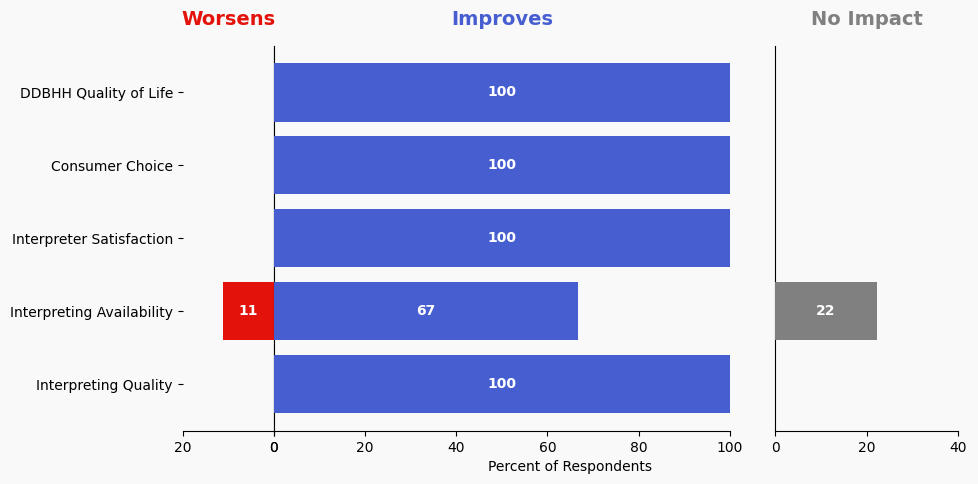9 Explicitly Teach DDBHH K12 and College Students about Working with Interpreters
Issue: There is no consistent formal education for DDBHH students to learn how to work with interpreters.
Proposed Solution: Commission and MDE provide training modules and guides in easily accessible formats (YouTube, Google docs) for DHH teachers and access coordinators to work with students as they learn what interpreters do, consumer rights, how to have discussions with interpreters, self-advocacy techniques, where to find resources and other ways to work effectively with interpreters.
Expected outcome: Consumers will understand their rights and have more techniques for working with interpreters; consumers will be more satisfied with interpreting services. Interpreters will work with consumers who are more informed about what interpreters do and how to work effectively with them; interpreters will have fewer demands due to consumers’ understanding of the interpreting process.
Who is impacted: Consumers, interpreters in both K12 and post-secondary settings, DHH teachers, college disability services
Timeline: 6 months

Summary of Support Image Description
The stacked bar charts show how respondents rated their level of support and the total number of responses. The percentage for the five support levels is shown from left to right: Strongly Oppose (Dark Red), Oppose (Light Red), Neutral (Yellow), Support (Light Blue), and Strongly Support (Dark Blue).
Respondents may identify with multiple subgroups. The overall level of support is:
Overall
Strongly Oppose: 1%
Oppose: 2%
Neutral: 12%
Support: 35%
Strongly Support: 50%
Click to see the detailed image description for each subgroup.
Interpreter
Strongly Oppose: 0%
Oppose: 0%
Neutral: 16%
Support: 30%
Strongly Support: 53%
Deaf
Strongly Oppose: 3%
Oppose: 2%
Neutral: 8%
Support: 43%
Strongly Support: 44%
DDBHH Consumer
Strongly Oppose: 3%
Oppose: 1%
Neutral: 10%
Support: 41%
Strongly Support: 44%
DeafBlind
Strongly Oppose: 0%
Oppose: 0%
Neutral: 0%
Support: 40%
Strongly Support: 60%
System Stakeholder
Strongly Oppose: 0%
Oppose: 2%
Neutral: 11%
Support: 34%
Strongly Support: 52%
Hard of Hearing
Strongly Oppose: 0%
Oppose: 0%
Neutral: 33%
Support: 33%
Strongly Support: 33%
Overview of Respondents Opting for In-Depth Solution Analysis
After indicating their support level, 7% of the 139 respondents opted in to further assess whether the solution would worsen or improve on five metrics. Of the opt-in reviewers (10 respondents), 100% supported the solution, 0% were neutral on the solution, and 0% opposed the solution.
The remaining 129 respondents did not opt in to further assess the solution. Of these people, 82% support the solution, 13% were neutral on the solution, and 3% opposed the solution.
Reviewer Evaluation of Solution Effectiveness

Solution Effectiveness Image Description
The stacked bar charts show how respondents assessed the effectiveness of this solution based on five metrics. For each metric, the percentage of respondents is shown from left to right: Worsens (Red), Improves (Blue), No Impact (Gray).
DDBHH Quality of Life
Makes It Worse 0%
Makes It Better 100%
No Impact 0%
Interpreter Satisfaction
Makes It Worse 0%
Makes It Better 100%
No Impact 0%
Consumer Choice
Makes It Worse 0%
Makes It Better 100%
No Impact 0%
Interpreting Availability
Makes It Worse 11%
Makes It Better 66%
No Impact 22%
Interpreting Quality
Makes It Worse 0%
Makes It Better 100%
No Impact 0%
Reviewer Feedback and Insights
Interpreter
Comments from Interpreters indicated that this solution could improve interpreting quality by empowering consumers with the knowledge on how to provide feedback to interpreters. Suggestions included interpreters receiving training on how to educate DDBHH students on their rights, and working with the Minnesota Department of Education and school districts to create a standard curriculum that is provided in schools.
Deaf, DeafBlind, Hard of Hearing
Comments from DDBHH Consumers suggested engaging the Collaborative Plan stakeholders, and highlighted multiple resources that can be leveraged to develop the curriculum, including NAIE, RID, other interpreting groups locally and nationally, and also suggested creating a K-12 version of NAD’s DSAT curriculum.
System Stakeholder
Comments from System stakeholders suggested including K-12 Education interpreters in the development of curriculum materials.
PREVIOUS SOLUTION
8 Establish a New Fund for Home & Community Services Interpreting Needs
Issue: DDBHH consumers are often denied interpreting services from home and community service entities due to ficial constraints.
NEXT SOLUTION
Issue: Not everyone is aware of all available resources, even though some sites with resources currently exist.
Leave a Reply